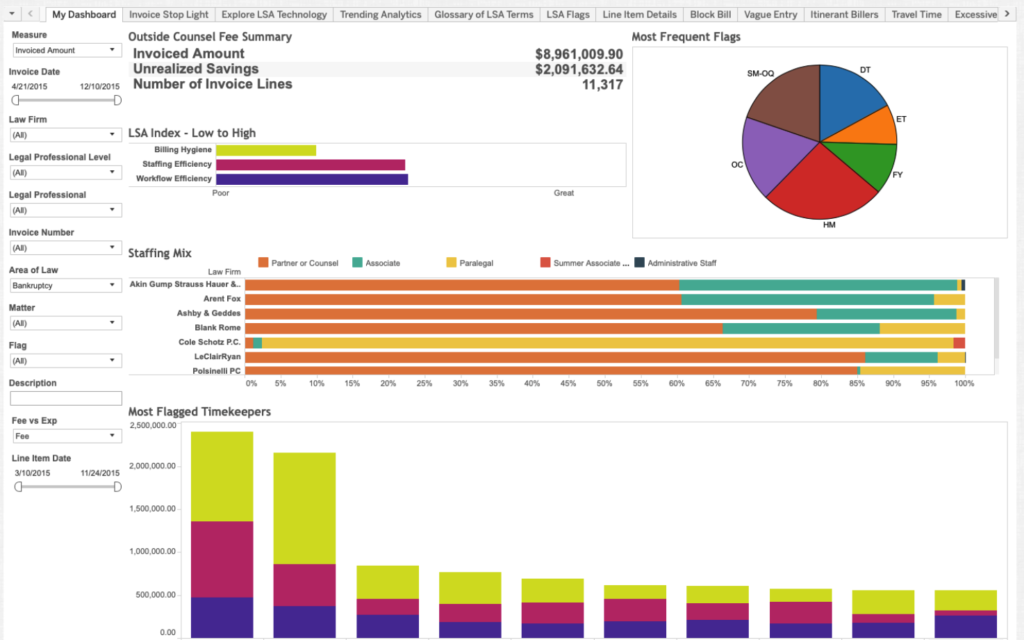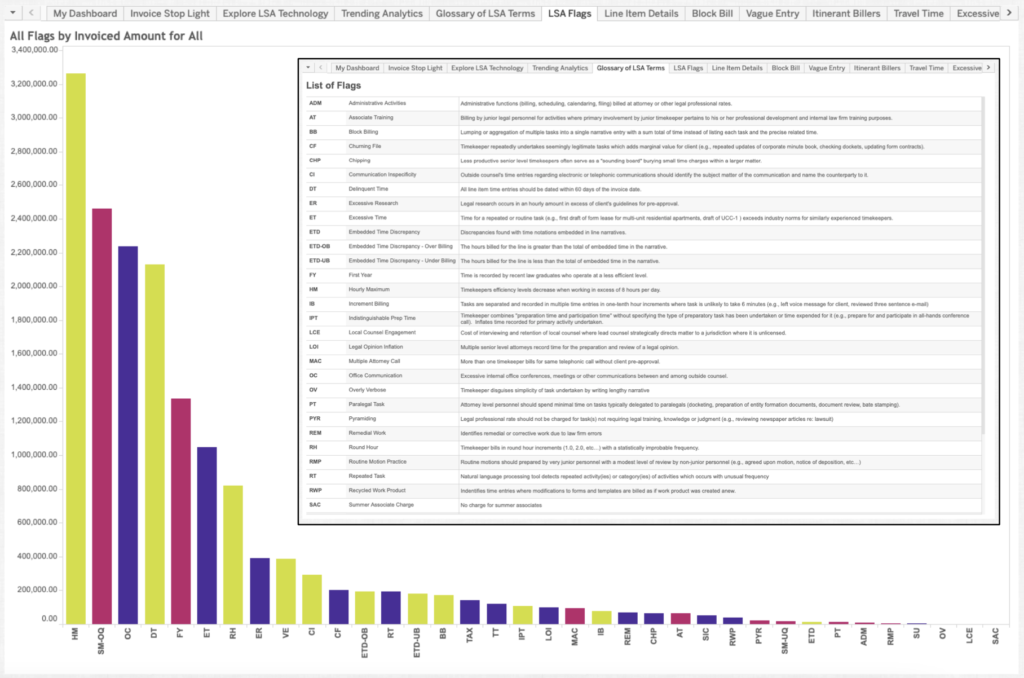The Case for Data-Driven Billing in the Legal Profession
To clients, legal billing can seem “like a black box.” Many clients worry about lawyers overstating their billable hours (“bill padding”) or charging exorbitant hourly rates. By using data analytics to optimize legal billing (“data-driven billing”), law firms can stand out from their competitors and win more business.
1 – Problems that Exist in Legal Billing
Bill Padding
There is cause for concern that legal costs are inflated. Bill padding is partially caused by high billable hours targets. As of 2016, the average associate was required to log 1,892 billable hours per year. These targets “virtually assure[] that some clients will be overbilled.” The economic model that governs law firm billing incentivizes firms to assess lawyers based entirely “upon the ability to generate revenue through the billable hour.” This type of assessment pressures lawyers to bill as many hours as possible. “[P]erceived billing expectations” have led at least some lawyers to inflate their logged billable hours. This sort of fraudulent billing makes law firms look bad and frustrates their clients.
The Cost of a Billable Hour
Despite concerns that billing by the hour may incentivize lawyers to be inefficient, law firms remain “wedded to the billable hour” because of the difficulty in estimating how much time legal work will take. Some firms set prices using cost-based, competition-based, or value-based pricing. Law firms also consider the firm’s expertise in the subject, market rates in the jurisdiction, the type of matter, and the type of client when setting prices. In general, the pricing strategy for many law firms is not data-driven. This lack of optimization suggests that current market prices are likely inflated. The opaqueness of legal billing practices leads to clients dreading the results.
2 – How Data-Driven Billing Can Help
Data-driven billing can help detect bill padding and intelligently set the price of billable hours. Billing software can identify bill padding through “scrutiniz[ing] bills to see irregularities and billing guideline violations” by comparing billable hour submissions against budgets and industry-wide data. Law firms can use pricing analytics to set pricing that will maximize the chance of getting not just a new client but also a profitable one. Using data analytics to minimize bill padding and intelligently set pricing allows law firms to differentiate themselves from competitors and maximize their profitability. “Pricing analytics is a huge untapped opportunity” for law firms. Although clients do not base their decisions purely on price, using data analytics to be an industry leader in pricing can help a law firm stand out in a competitive legal market.
The use of data analytics to analyze legal billing has grown rapidly. In 2014, auditing legal fees was identified as a growth industry. Since then, legal departments have expanded their use of data-driven billing and “have grown increasingly comfortable asking for and analyzing billing-related data.” There are now a large number of private companies that offer data-driven billing software, such as:
- Consilio offers its Sky Analytics software to analyze law firm invoice data to give legal departments cost-savings recommendations.
- Legal Decoder offers its Compliance Engine and Pricing Engine to help firms accurately price legal services to review billable hours and help determine future pricing.
- Lex Machina offers its Legal Analytics service which helps law firms analyze case timing, understand damage exposure, and assess parties’ track records to set competitive pricing.
- Quovant offers its LegalBill spend management tool to help analyze legal spend information.
- Time by Ping offers its automated timekeeping software for lawyers that allows law firms to provide value-based pricing.
3 – How Data-Driven Billing Works
Most data-driven billing software expands upon the Uniform Task-Based Management System (“UTBMS”) legal billing codes used to log billable hours. UTBMS codes were introduced by the American Bar Association in the mid-1990’s to standardize billing practices. While UTBMS codes “brought some clarity” to billing, the codes suffer “significant limitations” because of how broad they are. Legal billing data analytics software can use natural language processing, a form of artificial intelligence, to analyze the text descriptions accompanying time logs to determine exactly what a lawyer was doing and classify it more precisely than the default UTBMS codes can. The analytics software can then compare those classifications against historical data from the law firm and legal industry as a whole to flag potential bill padding. It will also help law firms efficiently price their services by providing them with historical billing data to use when determining pricing. This sort of data-driven pricing could become more important going forward if more law firms begin providing fixed-price quotes to clients instead of using billable hours to determine fees.
To learn more about how data-driven billing works, I spoke with Joe Tiano, the founder and chief executive officer of Legal Decoder. He explained that Legal Decoder uses proprietary natural language processing to analyze billing records and determine what a lawyer did at a more precise level. Legal Decoder has developed a set of proprietary billing categories that are more precise than the standard UTBMS codes. For example, a UTBMS code may indicate that a lawyer was working on a discovery matter, but it will not say whether it was a discovery motion, a deposition, or a motion to compel.
In the process of classifying each billable hour, Legal Decoder’s Compliance Engine looks for three types of problems with legal billing. First, it examines staffing efficiency, which asks whether the most competent and lowest cost lawyer was assigned to a task. For example, the software can detect if a firm is having a partner work on an task that an associate could handle. Second, it examines workflow efficiency, which asks whether a lawyer’s work is redundant or inefficient. Third, it examines billing hygiene, which ensures that the billable hour entries accurately record the time spent on a task.
After Legal Decoder’s proprietary software drills down to precisely classify each billable hour, it then analyzes how long each assignment took. Using historical data from industry-wide benchmarks, Legal Decoder’s Pricing Engine estimates how long each task should take and analyzes whether each matter was handled efficiently. Joe explained that although there can be variance in how long each task will take, the software can, for the most part, effectively estimate how long a task should take. Legal Decoder then presents the results from its Pricing and Compliance Engines in intuitive Tableau dashboards for its clients to analyze.
The following screenshots of the Legal Decoder dashboard were provided courtesy of Joe Tiano. All data displayed in the screenshots are from bankruptcy data and are in the public domain. © 2019 Legal Decoder, Inc. All rights reserved.


4 – How Increased Implementation of Data-Driven Billing Will Impact the Legal Industry
While describing how Legal Decoder’s software works, Joe explained that law firms are sitting on treasure troves of data that they are currently not leveraging. The success of companies like Legal Decoder demonstrates how valuable data-driven billing can be. The continued expansion of applying data analytics to legal billing will likely lead to several changes in the legal industry.
Data-Driven Billing Makes Law Firms More Attractive and Increases Predictability
It may seem like data-driven billing benefits clients and harms law firms by giving clients leverage to negotiate better pricing. Joe pushed back on that idea by explaining that through data-driven billing, law firms can increase their realization rate, which measures the difference between the amount of billable hours logged and what percentage of that time is ultimately paid for by the client. According to Joe’s previous research, as of 2016 roughly $60 billion in billable hours are lost due to the 83% net realization rate across the legal industry. Cost-conscious clients have increasingly begun to push back against what they perceive as inflated bills. In 2015, 68% of law departments received discounted fees by negotiating billing with outside counsel. Inside counsel for clients view receiving a discount as a way to flaunt their efficiency to their chief financial officer. Joe has previously written that by using data analytics to analyze legal billing, law firms can “operate more efficiently (and more profitably) with greater client attraction, retention, and satisfaction.” Put another way, by using data-driven billing, law firms can differentiate themselves from competitors and thus win more business.
Data Analytics Can Affect Partnership Decisions
Data-driven billing gives law firms another way to assess potential partners. Joe explained some of his clients use Legal Decoder’s software to analyze the work of potential partners. Without Legal Decoder’s software, law firms would evaluate an associate based on their total billable hours and overall feedback. Legal Decoder’s software lets law firms drill down into an associate’s billable hours and look for potential issues that would otherwise go unnoticed.
Pricing Will Become a More Important Differentiator in a Post-Covid Market
Most lawyers want to continue working remotely, even when it is safe to return to offices again. Working remotely could allow lawyers to live in lower cost of living areas, allowing firms to pay lower salaries for these lawyers. Law firms are reconsidering their expensive office leases and may look to downsize their square footage in the future. Paying for less office space could lead to law firms lowering their fixed costs. Clients are “smarter than ever before” and have exerted “a continual downward pressure on fees.” All of these trends indicate that pricing will be a more important differentiator between law firms than ever before. Data-driven billing can help a firm stand out by intelligently pricing its services.
Kyle Stenseth is a second-year law student at Northwestern Pritzker School of Law.
